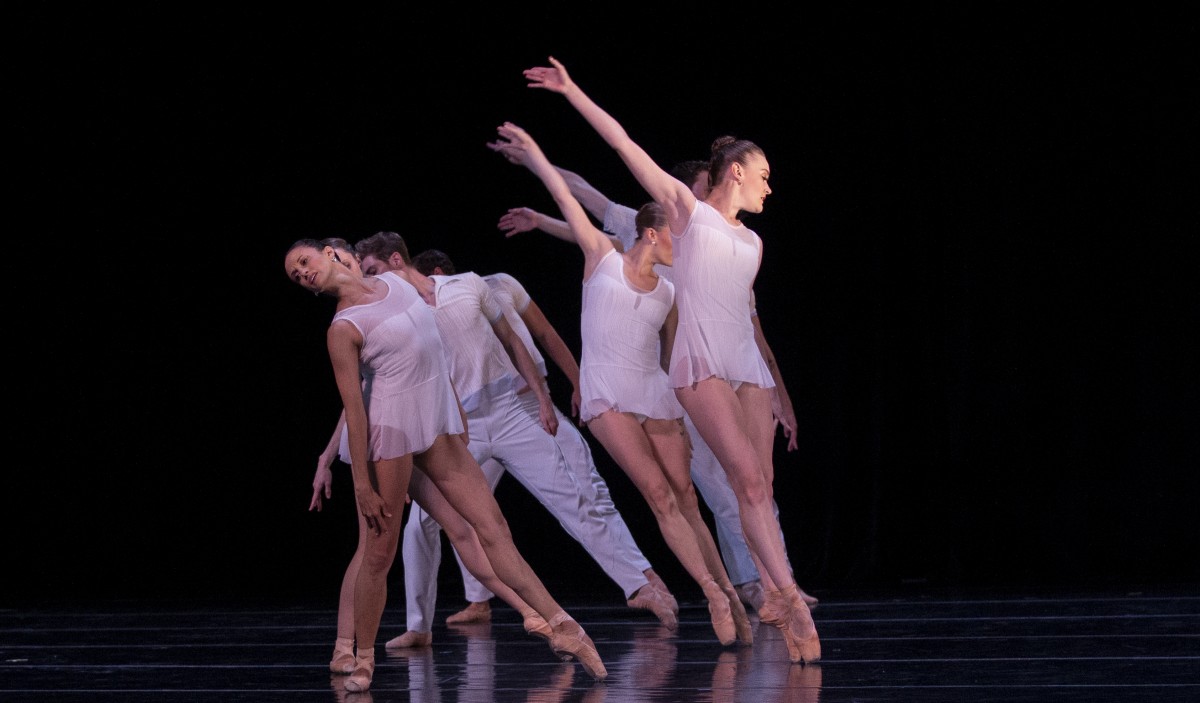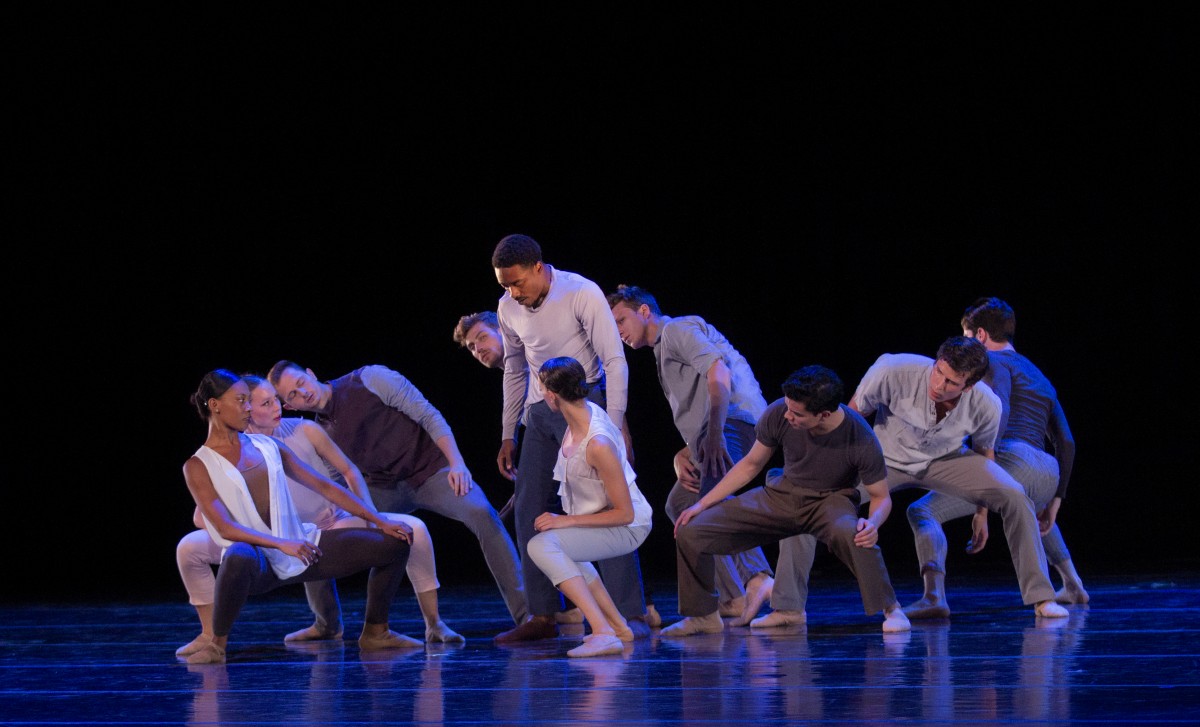Review by Steve Sucato:
Proving their exceptional July 3 “International Series” program was a hard act to follow, Charlotte Ballet’s final offering this summer, “Made in Charlotte,” on Monday night in the Amphitheater, was an up-and-down affair choreographically.
It began with a trio of ballets by Charlotte Ballet company dancers that all had their premieres this past May in Charlotte, as part of the company’s Choreographic Lab program. First to the stage was Sarah Hayes Harkins’ “Essence of Numbers,” danced to an original piano score by Ballet West music director Jared Oaks. The 12-minute contemporary ballet for eight dancers — including Hayes Harkins, who was a last-minute replacement for Amelia Sturt-Dilley — opened with the ballet’s four women, stiff as planks of wood, being held up at an angle by their four male counterparts. Costumed in all white, the four male-female couples shifted to the dancers forming same-sex partnerships for a floor-work series of steps.
Playing into its numerical title, Hayes Harkins’ deliberately incorporated into the abstract ballet equal pairings and clusters of male and female dancers throughout. And while Hayes Harkins’ sharply-angled choreography was precise, it was also less than captivating overall. The ballet’s best moments came in a pas de deux between dancers Alessandra Ball James and Josh Hall in which Ball James, in an arabesque position (supported on one leg, with the other leg extended directly behind the body with a straight knee,) appeared to stretch upward as if to touch the Amphitheater ceiling. The pas de deux then morphed into a trio with the addition of dancer Ben Ingel that saw the two men lift and flip Ball James around in various positions.
Next, Juwan Alston’s “A Road To Pieces” appeared to be a chip off “Essence of Numbers’ ” block stylistically. The 2-minute pas de deux danced by David Preciado and Hayes Harkins also hitched its wagon to being an interpretation of the music, in this case, Francis Poulenc’s “Sonata for Four Hands 1: Prelude,” and was more sharply-angled and delivered contemporary ballet movement, only performed faster.
While both these ballets by emerging choreographers had merit, if the expectation was in seeing work on a world-class level as in Charlotte Ballet’s previous “International Series” program, they, and “Made in Charlotte” overall, fell short of that.
The most surprising and interesting of the three dancer works, Chelsea Dumas’ “Sonnet 116,” the first of two Shakespearian-themed works to round out the program, came next. It was danced to recorded, atmospheric orchestral music composed by Thomas Wander and Harald Kloser that included a dramatic reading of Shakespeare’s love Sonnet 116 by Judi Dench. In terms of dance style, Dumas went in a completely different way from her colleagues, choosing a syncopated contemporary dance movement language for the work.
A promising choreographic talent, Dumas showed a level of craft and dance maker intuition that was impressive. In the piece’s opening duet between dancers Elizabeth Truell and Peter Mazurowski, Truell moved around a mostly statue-stiff Mazurowski touching, brushing against, leaning into and embracing him without touching him. It was an unconventional, yet moving portrait of love emotionally mirroring Shakespeare’s poetic verse spoken by Dench.
Dancers Raven Barkley and Maurice Mouzon Jr. soon replaced Truell and Mazurowski in a similarly-styled duet, whose movement rhythm matched the work’s music rhythm. The cast then expanded to a group of 11 as Dench’s voiceover came to an end, leaving only the fairytale-sounding music as a tide carrying Dumas’ pleasing unison group dance choreography to work’s end, the final scene being Mouzon Jr. slowly backing away from Truell to exit as the stage lights faded to black.
After an intermission, choreographer Stephanie Martinez’s marathon 45-minute ballet “Unsex Me Here” completed the program.
Commissioned by Charlotte Ballet and premiered last January by the company as part of their “Innovative Works” program, Martinez, along with playwright, theater and dance historian Lynne Conner dreamed up the concept and direction of the ballet which explored four of Shakespeare’s leading female characters: Juliet (Hayes Harkins), Lady Macbeth (Ball James), Titania (Sarah Lapointe) and Kate (Shaina Wire) from The Taming of the Shrew.
Titled after Lady Macbeth’s cry to the universe to be released from the gender norms of her time in Shakespeare’s Macbeth (Act I, scene 5), the underlying theme of “Unsex Me Here” was an exploration of gender roles and gender fluidity paralleling Shakespeare’s time with our current social climate.
Performed to music by Johann Sebastian Bach, George Frideric Handel, Bernardo Sassetti and Antonio Vivaldi, along with original music composed for the ballet by Peter De Klerk and Johnny Nevin, “Unsex Me Here” was all over the map musically, in its mix of dance movement styles (ballet, contemporary, musical theater, social) and in its level of choreographic sophistication. It felt at times haphazard, as if it were the product of several different choreographers of varying skill.
The ballet opened with Ball James as Lady Macbeth dancing in spotlight to a voiceover of her lines surrounding the ballet’s title from Shakespeare’s play Macbeth. Full of theatrical drama, Ball James was striking in sleek and stalking dance movement that ate up the stage in anger.
A horizontally-moving partition then crossed the stage revealing from behind it as it went, the ballet’s three other female protagonists. At first, the women danced in a gestural manner hinting at their literary identities and then in unison as a group. Martinez’s choreography for them evolved and devolved from carefully crafted technical dance phrases that showcased the women’s skill and prowess, to toss-away social dance squirmings that had them looking like recreational dancers. This dichotomy of movement sophistication would appear and disappear at times throughout the ballet.
Similar in approach to choreographer Val Caniparoli’s better known treatment of Norwegian playwright Henrik Ibsen’s heroines in his 2008 ballet Ibsen’s House for San Francisco Ballet, Martinez also paired her famous female literary characters with their male counterparts from their respective stories — Romeo (Ingel), Macbeth (Rees Launer), Bottom (Mazurowski) and Petruchio (James Kopecky) — to explore their dynamics as couples.
The ballet’s characters also appeared to ping pong across time from their Shakespearean personas to perhaps those same people if they were of our time, somewhat complicating the viewing experience. And while Martinez’s choreography showed inconsistency, she managed to pack in some highly entertaining and top-notch choreographic wallops, such as a Broadway-esque, testosterone-fueled, acrobatic and competitive men’s quartet full of lifts, jumps, hoots and hollers along with several humorous sections, including Lapointe as Titania and Mazurowski as Bottom from A Midsummer Night’s Dream dancing in character in a slapstick duet to Judy Garland’s renditions of “You Made Me Love You” and “The Trolley Song.”
Wonderfully performed by Charlotte Ballet’s dancers, “Unsex Me Here” finished with a flourish courtesy of several carefully crafted and technically dazzling pas de deuxs between the various male-female character pairings that each ended with a voiceover line by the female protagonist; those ending pas de deuxs lifting the ballet’s energy and interest, giving rise to an enthusiastic standing ovation by the lightly populated Amphitheater audience.
Based in Painesville, Ohio, Steve Sucato is a contributing writer, critic and reporter. His work has appeared in such publications as The Plain Dealer, The Buffalo News, Pittsburgh City Paper and Dance Magazine, among others.







